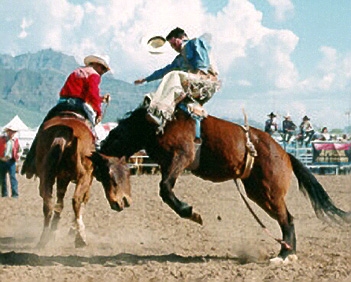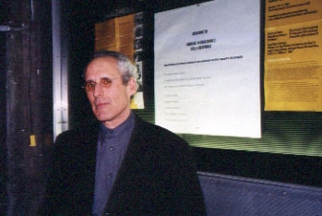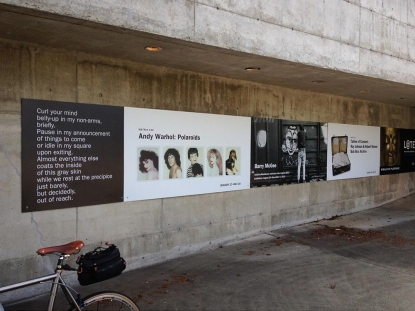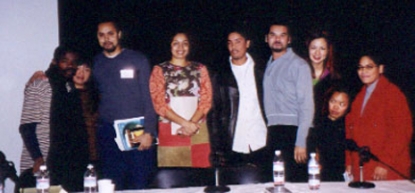Feature: Reviews
Worlds In Collision at SFAI
- San Francisco Art Institute
- January, 2001
“What I’d like to add are some reflections on the effects of symposia generally- on us as artists, on shaping a community, on how they can act as an invisible connective tissue through a place, artworks, community policy. That’s ultimately what’s interesting about them, is that they exist ephemerally and pass into unconscious levels of thought, or lore and legend- they have a slippery effect.” – Ella Delaney
When Ella first approached me to write a companion piece to her review of the Deleuze conference at CCAC, I meditated on this concept of symposia. The word conjures up images of privilege and staid, sterile environments. I pictured an auditorium filled with people who would be offended if a paperback were to graze their inlaid oak bookshelves, or who would sip on chilled French white wine while discussing French theory. But I knew that this initial reaction was as shallow and narrow as the people I envisioned filling it.
Instead I turned to the notion of an organized community gathering and the sharing of ideas. Based on this, the first symposia that I’d attended were the rodeos that I’d go to with my family as a kid growing up in Montana. Every year we’d pack up our god-awful gold station wagon and drive an hour from Billings to Red Lodge for the 4th of July, listening to Waylon and Willie as we wove our way through Big Sky country. The Home of the Champions Rodeo was a three-day event that included a parade each day, a “mutton busting” contest for which kids would be placed on sheep, wriggling and giggling as the clock timed how long the little dogies could ride it out, and the rodeo itself which featured bareback, saddlebronc, calf roping, team roping and steer wrestling (among others.) Folks from all over the West and beyond would converge on the small town to take part in the festivities and exchange tips and stories that ranged from who was breeding the best lineback dunns (yellowish brown horse with a black line running down the spine) to recipes for baked beans. It was a way of sharing information with others while having a hell of a lot of fun and showing off the best cowboys, cowgirls and rodeo stock in the country.
While a weekend of buckin’ broncs and pootin’ ponies is a very different experience from an arts-related symposium, when a similar grassroots community spirit pervades it, there is great potential for impacting social change and policy. The structured setting also creates a safe environment for disparate groups to share and exchange potentially unpopular viewpoints, discussing sensitive subjects such as race, gender and sexual identity.
Worlds in Collision 2: Call & Response was an inspiring and provocative weekend long symposium co-organized by faculty member Carlos Villa and curator Eungie Joo that reconsidered race, ethnicity, multiculturalism and identity at the San Francisco Art Institute January, 2001. The 3-day event grew out of a discussion that began at the school over 25 years ago. In 1976, Villa organized the bicentennial exhibition, Other Sources: An American Essay. The show, which included theater, dance, music, food, and visual art, represented one of the first local efforts to challenge the American canon of art within the contexts of multiculturalism and community. This historic occasion was followed by four symposia that took place within a three-year period at the Art Institute during the late eighties. The discussions and debates that transpired led the Art Institute to institutionally recognize multiculturalism as a complex and critical topic that students believed was missing from their education. As a result, the Worlds In Collision course was added to the school’s curriculum in 1989. Villa developed the course, introducing alternative perspectives and models for understanding art and art education. Guest artists and activists from various Bay Area communities were asked to visit and speak about their art and their communities, their ethnicity and their culture.
In the early nineties I was a part of the growing number of students who were outraged by the white, Euro-centric, male status quo reflected in our educational systems - in the forms of institutional representation and curriculum. In 1991, as a student representative from the University of Oregon, I sat on the panel "Sexism in the Classroom" at the National Women’s Caucus for the Arts Conference in Chicago. The conference helped to instill in me a sense that I was supported in my efforts to challenge gender inequity and the confidence to continue and to support others doing the same.
Ten years later, I found myself sitting at Worlds In Collision 2 at the Art Institute (where I received my MFA in ‘97) listening to the voices of those who have helped to shape the discussions of race, ethnicity, multiculturalism, and identity over the past 30 years. Those voices included: Carlos Villa, Amalia Mesa-Bains, Charles Gaines, Janeen Antoine, Moira Roth, Fred Wilson, Nao Bustamante, and the Black Dot Artists Collective. The question that echoed throughout the weekend was "where are we now?" – how have the discourses of multiculturalism, identity politics, and diversity shifted and what debates, outcomes, contexts, and meanings remain?
The symposium opened on Friday night with a "fireside chat" between David Ross, director of the San Francisco Museum of Modern Art, and Amalia Mesa-Bains, director of the Institute of Cal State at Monterey, artist, cultural activist, and recipient of the distinguished MacArthur Foundation fellowship. The most striking impression left by the conversation was the way in which it reflected the anticipated perspectives of a white man working from inside the institutionalized cultural system and a Chicana artist who spent many years challenging that established structure.
The two began by reflecting upon the 1993 Whitney Biennial, the Decade Show and the Black Male show, three pivotal exhibitions that challenged cultural access and representation in the early ‘90s. Ross, who was director of the Whitney Museum at that time, believed that the Whitney changed as a result of these shows and that people who had been marginalized were establishing a voice, albeit "glacially." Meanwhile, Mesa-Bains saw the exhibits as an impetus for activists to create their own institutions, in their own communities.
The discussion’s focus then shifted to the question "What were the issues of multiculturalism then?" I was dismayed and disappointed to hear Ross summarize the feminist art movement of the ‘70s as ultimately about abortion and women’s right to have control over their own bodies. I felt that Mesa-Bains better addressed the intent of those excluded from the canon when she stated "We wanted to tell our stories, we wanted to tell it ourselves, in our words." She concluded by suggesting that now "we need to find a way to make our own language, to go from highly intellectual dialogue to the dialogue of the community. To circulate and develop a language to describe ourselves, not to be described by someone else."
The second day included the panel "Multiculturalism, Identity, Diversity (1990-95): From the Decade Show to the 1993 Whitney Biennial, From Black Male to Asia/America." This presentation by curators, writers and artists reinforced Mesa-Bains’ view that the critically challenging exhibits of the early ‘90s resulted in the emergence of many new cultural institutions that functioned outside of the mainstream status quo. The spirit of the discussion reached a magical high when a member of the audience announced that President Clinton had pardoned Leonard Peltier earlier that day. Janeen Antoine, director of American Indian Contemporary Arts was at the podium and left speechless by the news, while many of us in the audience felt tears of disbelief and hope welling up in our eyes. It was painful to learn later that we had been misinformed, however, the emotions of that moment were just as much in celebration of the struggles and victories that have been experienced by outsider communities over the past twenty-five years.
Sunday concluded with a panel featuring young artists who continue exploring cultural identity in their work. Edgar Arceneaux, De La Torre + Morales, Black Dot Artist Collective, Paul Pfeiffer, and the Mail Order Brides presented current projects and addressed their discomfort with the mandate to represent their communities, expressing the desire to broaden their scope beyond ethnicity.
This discussion was followed by a response from two past participants (WIC 1990) who directly posed the question to panelists "What are you (as artists) doing with the legacy passed on to you from artists who fought hard during the 60’s and 70’s?" The collective reaction was one of wanting to establish and define their own relationship to cultural representation and not to feel constrained by the agenda of another generation. While this confrontation could be interpreted as a disheartening end to the weekend, Carlos Villa’s reflection thoughtfully summarized the experience, "It’s all about the questions you leave with, not the answers" - reminding us that the discussions surrounding art, culture and community are part of an ongoing evolution.
I did leave the weekend filled with questions. I also left (as I had the WIC conference in ‘91) with the sense that I am supported in my beliefs – I am not crazy or overly sensitive when I open up a publication and the first thing that I do is to count the number of articles by and about women and men of color, or look critically at the representation offered by educational and cultural institutions and challenge these bodies when they fall short. I also left with a deep respect for the people who helped to create a framework for defiance and resistance and whose legacies continue (whether acknowledged or not) influencing the ongoing cultural evolution.
In a broader context, the weekend was an opportunity to reflect on the relationships between multicultural agendas, community interests and art over the past thirty years — to celebrate the grassroots efforts that have helped make imperative changes within our educational systems, art institutions, literary publications, and public perceptions and to acknowledge the challenges and blinders that still exist within the same. I look forward to the work that will be done over the next ten years, inspired in part by this gathering, and to reconvening in 2011 to share our experiences and continue the dialog.




